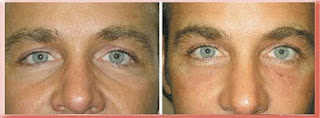Patients with dark circles under their eyes complain that they look tired. The condition is called periorbital hyperpigmentation. Environmental factors that make the condition worse include sunlight exposure, hayfever, lack of sleep, stress, alcohol overuse and smoking.
The condition is classified by appearance as:
- pigmented (brown color)-congenitally darker skin, nevus of Oti or Hori, dermal melanocytosis, side effect of eyedrops, inflammatory induced pigment increase associated with atopic or allergic dermatitis or eyelid rubbing associated with allergiesincreased pigmentation from inflammation
- vascular (blue, pink, purple color)-increased blood vessel densityblue color and structural (tear trough) both treated by filler injection
- thin skin making the underlying muscle color visiblethin lower eyelid skin shows muscle under it
- structural (shadows formed by the surface contours such as eyelid bags, eyelid swelling or tear trough visibility associated with aging)shadows from eyelid bags
- mixture of 2 to 4 of the above classes
The treatments available fall under 2 categories:
Topical depigmenting agents
- hydroquinone
- kojic acid
- azelaic acid
- arbutin
- retinoic acid
Other modalities
- chemical peels-glycolic acid 20% or lactic acid 15%+trichloroacetic acid 3.75%
- filler injections
- surgery-fat grafting, blepharoplasty
- laser-Q switched ruby (694nm), Q switched alexanderite and Nd:Yag (1064nm)
- stop medications causing the condition
Hydroquinone in 2 to 6% strength applied to the eyelids is effective and safe but cannot be used long term because of the risk of ochronosis, a permanent skin discoloration. Kojic acid comes from the same mold as penicillin. It can be applied in 1 to 4% concentration to lighten skin color but can irritate the skin. Azeliac acid works by killing pigment cells, is well tolerated by the skin and can be used long term without side effects. Arbutin is a plant extract that inhibits pigment manufacture and maturation of the cell packet containing pigment but at concentrations can have the opposite effect. Combination formulas such as Klingman’s (4% hydroquinone, 0.05% retina-A, 0/01% steroid) and a mix of Kojic acid, 10% glycolic acid and 2% hydroquinione are FDA approved for skin lightening but again have risks associated with long term use. In darker skinned individuals chemical peels may create a visible line of demarcation between peeled and non-peeled skin or may be contraindicated. For optimal results peeled skin should be pretreated with retin-A and hydroquinone for 2 to 4 weeks. Lasers such as have yielded good results especially when the skin is pretreated. Structural causes of dark under eye circles can be treated with blepharoplasty, fat grafting and/or filler injections.
Latanoprost and bimatroprost eye drops, used to treat glaucoma, stimulate increased eyelid skin pigment production by pigment cells. The pigmentation becomes visible after 3 to 6 months of use and reverses when eye drops are discontinued. If the dark circles disappear in direct lighting or when the eyelid skin is stretched the problem is structural and the surface contour is creating a shadow. If the dark circle gets darker the problem is thin skin and as you thin it even more by stretching it the underlying muscle shows through even more.









Join the Discussion!